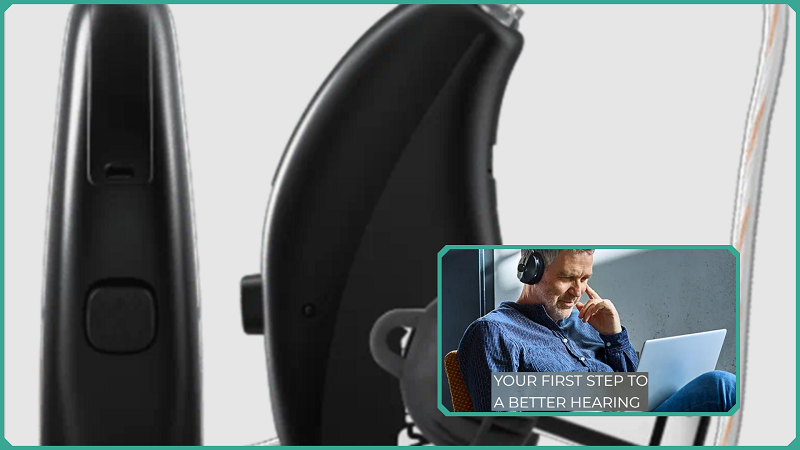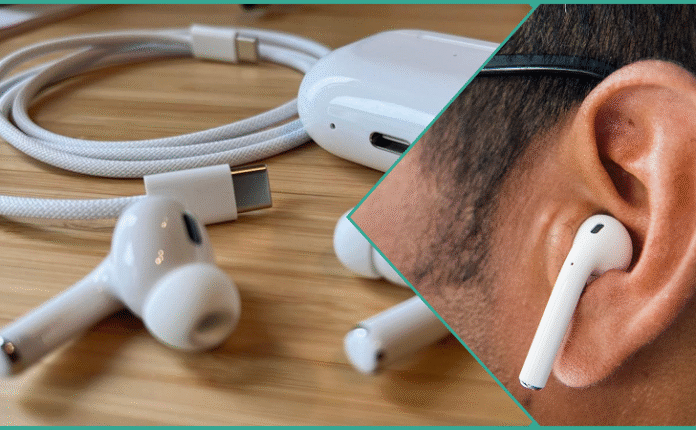Bluetooth earbuds have become an essential part of daily life for millions in today’s world. Whether you’re a commuter drowning out city noise, a fitness enthusiast powering through workouts, or a remote worker attending virtual meetings, earbuds offer convenience and personal audio immersion.
However, prolonged and continuous use over extended periods, particularly when listening at high volumes, can greatly increase the risk of causing serious and potentially irreversible damage to your overall hearing health and auditory system.


This detailed and comprehensive guide has been thoughtfully created to help you effectively protect your hearing health. It provides valuable information and practical tips to ensure you can enjoy your Bluetooth earbuds safely and responsibly, even during extended periods of use. By following the advice in this guide, you will be able to maintain your hearing health without compromising your listening experience.
Why Protecting Your Hearing Matters
Hearing loss caused by earbuds is often a gradual and irreversible process. This type of hearing damage is known as noise-induced hearing loss (NIHL), which happens when the tiny, delicate hair cells inside your inner ear become damaged due to exposure to excessive sound levels over time.
Unlike sudden loud noises that cause immediate damage, prolonged exposure to moderately loud sounds—such as music played too loudly through earbuds—can silently and steadily erode your hearing ability without obvious warning signs.
This risk is particularly significant for frequent earbud users, especially young adults and teens, who often listen for extended periods. Many of these users unknowingly exceed safe volume limits, frequently turning up the volume to drown out background noise in environments like public transport, gyms, or busy streets. This behavior accelerates the risk of permanent hearing damage.
Protecting your hearing now is crucial. By adopting safe listening habits today, you ensure that you can continue to enjoy your favorite music, podcasts, and conversations clearly and comfortably for many years to come. Your hearing is a vital sense that connects you to the world—taking steps to safeguard it is an investment in your long-term quality of life.
Understanding Key Concepts: Volume, Duration, and Noise Isolation
Volume and Duration: The 80-90 Rule and 60/60 Rule
When it comes to protecting your hearing while using Bluetooth earbuds, two critical factors to manage are volume and duration of listening. Experts emphasize that both how loud you listen and how long you listen significantly impact your risk of noise-induced hearing loss (NIHL).
- The 80-90 Rule: This guideline recommends listening at no more than 80% of your device’s maximum volume and limiting your total listening time to 90 minutes per day. Staying within these limits helps reduce the cumulative damage caused by loud sounds.
- The 60/60 Rule: Another popular approach advises listening at 60% volume for no more than 60 minutes at a time, followed by a break. This method encourages regular rest periods for your ears, allowing them to recover and reducing fatigue.
Both rules emphasize the crucial importance of carefully balancing not only how loud you listen but also how long you are exposed to the sound. Even moderate volumes, which might seem safe at first, can lead to significant hearing damage if the exposure is prolonged over an extended period. Therefore, adopting these listening habits is essential to protect your hearing and maintain long-term auditory health and well-being.
Noise Isolation and Noise-Cancelling Technology
A common reason people increase their earbud volume is to overcome background noise, whether on a busy commute, in a gym, or in a noisy office. Unfortunately, this often leads to listening at unsafe volume levels.
To effectively counter this issue, using earbuds or headphones equipped with high-quality and effective noise isolation or advanced active noise cancellation (ANC) technology can make a truly significant and noticeable difference in your listening experience:
- Noise Isolation: This is a passive method where the earbuds physically block external sounds by creating a tight seal in your ear canal. Good isolation reduces ambient noise, so you don’t need to crank up the volume.
- Active Noise Cancellation (ANC): ANC uses built-in microphones and electronic processing to detect and cancel out background noise by producing sound waves that neutralize ambient sounds. This technology is particularly effective in low-frequency noise environments, such as airplanes or trains.
By effectively reducing external noise, both noise isolation and active noise cancellation (ANC) technologies enable you to listen to your audio comfortably at much lower volume levels.
This significant decrease in the need for high volume not only enhances your overall listening experience but also greatly lowers the risk of potential hearing damage. At the same time, you can still enjoy clear, immersive, and high-quality sound without distractions from the surrounding environment.
In summary, thoroughly understanding and effectively applying these essential key concepts—such as carefully controlling the volume levels and managing the duration of use, as well as leveraging advanced features like noise isolation or active noise cancellation—are foundational and critical steps to help you consistently protect your hearing health when using Bluetooth earbuds regularly.
Practical Tips to Protect Your Hearing While Using Bluetooth Earbuds
Protecting your hearing while enjoying the convenience and freedom of Bluetooth earbuds doesn’t have to be a complicated task. By incorporating a few straightforward and practical habits into your daily routine, you can greatly reduce the risk of noise-induced hearing loss and ensure that your ears remain healthy and strong for many years into the future.
Here are six essential and effective tips to help you safeguard your hearing while still enjoying your favorite audio:
Choose the Right Earbuds for Fit and Noise Isolation
A proper fit is the foundation of safe listening. Earbuds that don’t seal your ear canal well allow external noise to seep in, which often causes you to raise the volume dangerously high to compensate.
- Opt for earbuds with multiple ear tip sizes so you can find the best fit for your ears. A snug, comfortable seal not only improves sound quality but also blocks out ambient noise.
- Consider noise-cancelling earbuds or over-the-ear headphones with active noise cancellation (ANC) if you frequently listen in noisy environments like public transport, gyms, or busy streets. These technologies reduce background noise, allowing you to listen at lower, safer volumes.
Monitor and Limit Your Volume
Being mindful of how loud you listen is critical. Here’s a simple test: if you can’t hear someone speaking to you at arm’s length without them raising their voice, your volume is likely too high.
- Use built-in volume limit settings on your devices:
- On iPhones, enable Headphone Safety in Settings to automatically reduce loud audio.
- Many Android devices offer a Volume Limiter feature.
- There are also third-party apps that monitor and cap volume levels.
- Aim to keep your volume below 85 decibels (dB)—roughly the noise level of heavy city traffic, which is considered a safer listening threshold.
Follow Safe Listening Time Guidelines
Even when listening at moderate volumes, extended periods of exposure can lead to ear fatigue and potentially cause lasting damage to your hearing health. Prolonged listening sessions, even if the sound is not excessively loud, may still strain your ears over time, increasing the risk of auditory issues.
- Limit continuous listening sessions to 60 to 90 minutes.
- Take regular breaks to rest your ears, allowing the delicate hair cells in your inner ear to recover.
- For longer listening periods, reduce the volume further to minimize strain.
Invest in Quality Earbuds with Volume Limiting Features
Higher-quality earbuds often deliver clearer sound at lower volumes, reducing the temptation to crank up the volume for clarity.
- Look for earbuds with built-in volume-limiting technology that automatically caps sound levels at safe thresholds.
- These models are especially useful for parents who want to protect their children’s hearing or for anyone who tends to listen loudly.
Maintain Good Earbud Hygiene
Earbuds can easily accumulate bacteria and earwax over time, which significantly increases the risk of developing ear infections. These infections can cause discomfort and pain and may also indirectly affect hearing by leading to temporary or even more lasting issues with ear health. It is important to regularly:
- Clean your earbuds regularly according to the manufacturer’s instructions.
- Avoid sharing earbuds with others to reduce the risk of transferring bacteria.
- Proper hygiene helps keep your ears healthy and reduces complications that can impact hearing.
Be Aware of Your Environment
While noise-cancelling earbuds are excellent for effectively blocking out a wide range of distracting sounds, they can also significantly reduce your overall awareness of your immediate surroundings. This diminished environmental awareness may affect your ability to stay alert to important sounds or situations around you.
- Avoid using noise-cancelling earbuds in situations where you need to stay alert, such as walking near traffic or in potentially hazardous environments.
- Use them primarily in safe, controlled settings to balance hearing protection with situational awareness.
By carefully following these practical and effective tips, you can fully enjoy your Bluetooth earbuds while simultaneously protecting your hearing from potential long-term damage. Making small but consistent changes in the way you listen today can have a significant and positive impact on preserving your ear health for many years to come, ensuring you maintain good auditory function well into the future.
Latest Trends and Innovations in Hearing Protection
As awareness about the importance of hearing health continues to grow significantly, both technology and educational efforts are advancing at a rapid pace to assist people in protecting their hearing. This is especially crucial as more individuals use audio devices such as Bluetooth earbuds in their daily lives. These developments aim to help users enjoy their audio experience safely without compromising their long-term hearing ability.
Here are some of the most notable and impactful trends and innovations that are currently shaping the landscape of hearing protection today and into the near future:
Smartphone Health Apps for Hearing Monitoring
Modern smartphones today are increasingly equipped with advanced health applications designed to monitor and track headphone audio exposure over extended periods. These apps provide valuable alerts to users whenever their listening levels surpass recommended safe thresholds.
For instance, Apple’s Health app incorporates guidelines established by the World Health Organization (WHO) to carefully analyze headphone audio data. This integration helps users maintain their listening habits within safe limits, significantly reducing the risk of noise-induced hearing loss and promoting better long-term auditory health.
Beyond volume tracking, specialized hearing aid apps (such as MyPhonak, Widex Moment, and Oticon Companion) offer features like:
- Remote volume and program adjustments
- Noise cancellation control
- Tinnitus management through sound therapy
- Direct streaming from phone to hearing aids
These innovative apps empower users to take full control of their hearing health by actively managing various aspects of their auditory experience. They offer personalized options that allow users to customize their listening environment to suit their unique preferences and needs.
Additionally, these apps provide the convenience of connecting with professional audiologists remotely, enabling users to access expert telehealth consultations from the comfort of their own homes without the need for in-person visits.
Volume-Limiting Earbuds
Recognizing the risks of excessive volume, several manufacturers now offer earbuds with built-in volume-limiting technology. These devices automatically cap the maximum volume output, typically around 85 decibels, which is considered a safer threshold for prolonged listening.
Volume-limiting earbuds are particularly popular among parents who want to protect their children’s hearing and for individuals prone to listening at unsafe volumes. This innovation reduces the risk of noise-induced hearing loss by preventing accidental overexposure to loud sounds.
Custom-Fit Earbuds
Advances in 3D scanning and printing technology have enabled the production of custom-fit earbuds tailored precisely to the unique shape of an individual’s ear canal. These earbuds provide superior noise isolation and comfort compared to generic models.
Better noise isolation means users don’t need to increase volume to block out ambient noise, significantly reducing the risk of hearing damage. Custom-fit earbuds also enhance sound quality and reduce ear fatigue, making them an excellent choice for frequent listeners.
Educational Programs and Awareness Campaigns
Alongside the rapid technological advancements taking place, there is an increasingly strong emphasis being placed on hearing health education. This focus is particularly directed at young people, who are among the heaviest users of personal audio devices such as headphones and earbuds. Educating this demographic about the importance of protecting their hearing is becoming a crucial priority.
- Schools and public health organizations are launching campaigns to teach safe listening habits, such as:
- Understanding the dangers of loud and prolonged listening
- Applying the 60/60 or 80-90 rules for volume and duration
- Encouraging regular hearing check-ups
These programs are specifically designed to instill lifelong habits that actively protect hearing health and significantly reduce the incidence of noise-induced hearing loss among future generations. By fostering awareness and encouraging consistent protective behaviors from an early age, these initiatives aim to create a lasting impact that preserves auditory health throughout individuals’ lives.
Summary of the Latest Trends and Innovations in Hearing Protection
| Innovation | Description | Benefits | Target Users |
|---|---|---|---|
| Smartphone Health Apps | Track audio exposure, volume limits, and tinnitus management | Real-time monitoring, personalized control | All users, especially tech-savvy |
| Volume-Limiting Earbuds | Earbuds with built-in volume caps | Prevents accidental loud listening | Parents, young users, volume-prone |
| Custom-Fit Earbuds | 3D printed earbuds tailored to the ear shape | Superior noise isolation, comfort | Frequent listeners, audiophiles |
| Educational Programs | Awareness campaigns and school programs | Promotes safe listening habits | Teens, young adults, parents |
These groundbreaking innovations collectively empower users to enjoy their audio devices safely and responsibly while significantly minimizing the risk of long-term hearing damage and related health issues.
By thoughtfully combining advanced technology with comprehensive education and awareness programs, the future of hearing protection appears bright and promising, offering effective solutions that ensure more people can actively preserve their hearing health.
This is especially important in an increasingly noisy world where exposure to loud sounds is more common than ever before, making hearing preservation a critical priority for overall well-being.
FAQs
Are Bluetooth earbuds safer than wired earbuds for hearing?
The risk of hearing damage depends primarily on the volume and duration of listening, not whether the earbuds are wireless or wired. Bluetooth earbuds can be just as harmful as wired ones if used at high volumes for extended periods. Safe listening habits are key regardless of the type of earbuds.
Can noise-cancelling earbuds damage my ears?
Noise-cancelling technology itself is safe and can help protect your hearing by reducing the need to increase volume in noisy environments. However, prolonged use of any earbuds, including noise-cancelling ones, in situations where you need to stay alert may reduce your awareness of hazards, so use them wisely.
How loud is too loud when using earbuds?
A simple test is if you cannot hear someone speaking to you at arm’s length without them raising their voice, the volume is too loud. Experts recommend keeping your volume below 85 decibels (dB), which is roughly the noise level of heavy city traffic and considered a safer threshold for prolonged listening.
How often should I take breaks from listening?
To protect your hearing, take a 5-10 minute break every hour of listening. Alternatively, follow the 60/60 rule: listen at 60% volume for no more than 60 minutes, then give your ears a rest. Regular breaks help prevent ear fatigue and reduce the risk of hearing damage.
Can earbuds cause permanent hearing loss?
Prolonged exposure to loud sounds through earbuds can cause irreversible noise-induced hearing loss (NIHL). This damage accumulates over time and cannot be undone. Early adoption of safe listening habits is essential to preserve your hearing health for the long term.
If you begin to notice symptoms such as ringing in your ears, also known as tinnitus, muffled or unclear hearing, or if you find it increasingly difficult to understand conversations even in quiet settings, it is important to consider consulting a hearing care professional without delay. Seeking timely advice can help address these issues effectively and prevent the potential worsening of your hearing health.
In Conclusion
Bluetooth earbuds offer incredible convenience and high-quality sound, making them a staple in our daily lives. However, improper use can put your hearing at risk. To protect your hearing, it’s essential to control the volume, limit your listening time, and select earbuds that provide effective noise isolation or active noise cancellation.
Leveraging technology such as volume limiters and smartphone health apps can help you monitor and manage your listening habits more effectively. Equally important is taking regular breaks and maintaining good ear hygiene to prevent infections and discomfort.
By adopting these practical strategies, you can continue enjoying your favorite music, podcasts, and calls while safeguarding your hearing health for the long term. Remember, your ears are irreplaceable—treat them with care to keep the soundtrack of your life vibrant, clear, and enjoyable for years to come.
Discover more from BizTechNomy
Subscribe to get the latest posts sent to your email.


